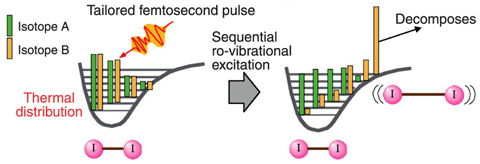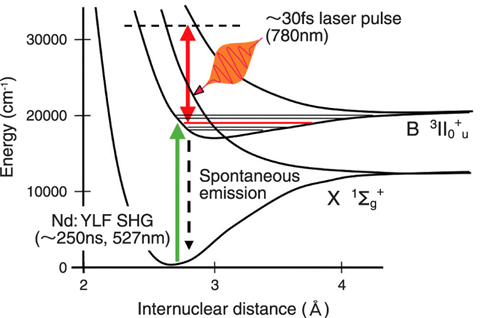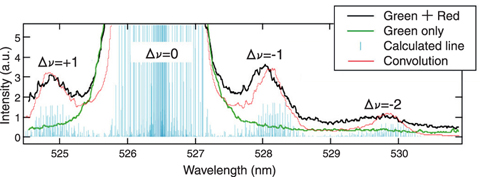
Fig.4-13 Schematic drawing of new isotope separation scheme using coherent quantum control

Fig.4-14 Potential energy curves of the iodine molecule and excitation scheme

Fig.4-15 Fluorescence spectrum
Isotope separation is one of the important technologies for the nuclear fuel cycle in our country. We are involved in fundamental research to develop new isotope-separation schemes using advanced laser devices. In one such recent study, we successfully demonstrated an elementary step important for the precise control of molecular vibration.
Conventional schemes of isotope separation using narrow band lasers are hard to extend to heavy elements, in which the isotope shift in the absorption spectrum is small and thus vulnerable to thermal noise. To overcome this difficulty, we are searching for new separation schemes based on broadband lasers, which can provide a strong and flexible way to control molecules with a newly developed pulse shaping technique and called "coherent quantum control".
According to our recent theoretical studies, the isotope shift is amplified by two orders of magnitude at a sufficiently high vibrational level. To take advantage of this, we must develop the multiple excitation of molecular vibration, keeping the vibrational levels under control (Fig.4-13).
The experiment was carried out at the Kansai Photon Science Institute. Iodine molecules excited to the B state by a green laser was exposed to red ultra short laser pulses of 30fs (1fs = 10-15s, Fig.4-14). The dispersed fluorescence spectrum emitted when returning from the B state to the X state was measured, and the change in vibrational energy was found to obey quantum mechanics (Fig.4-15). The process observed here, Raman scattering from the B state, had not been reported previously. In addition, we found that the direction of vibrational energy change can be controlled by chirping (temporal change of wavelength within a single pulse). In our next step, we will try to achieve multiple molecular vibration excitations and demonstrate that the isotope selectivity is thereby enhanced.
The vibration control presented here can be used for the amplification of a small isotope shift. After the amplification, conversion of chemical form and physical separation must be studied to realize a new isotope separation technique.